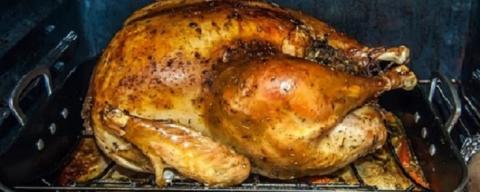Time for Turkey Tips
Food safety is especially important as you prepare a holiday meal. Within the last couple of years, the Centers for Disease Control has investigated outbreaks of foodborne illness caused by bacteria in jalapeños, spinach, peanut butter, frozen pizza, frozen pot pies, and frozen beef patties. Many consumers are now more aware of the ongoing importance of food safety.
When preparing a turkey, be aware of the four main safety issues: thawing, preparing, stuffing and cooking to adequate temperature.
How to Safely Thaw a Turkey
Thawing turkeys must be kept at a safe temperature. The “danger zone” is between 40 and 140 degrees Fahrenheit — the temperature range in which foodborne bacteria multiply rapidly. While frozen, a turkey is safe indefinitely, but as soon as it begins to thaw, bacteria that may have been present before freezing can begin to grow again if it is in the “danger zone.”
There are three safe ways to thaw food: in the refrigerator, in cold water, and in a microwave oven. Read more about thawing here.
How to Safely Prepare a Turkey
As you prepare the turkey, bacteria present on raw poultry can contaminate your hands, utensils, and work surfaces. If these areas are not cleaned thoroughly before working with other foods, bacteria from the raw poultry can then be transferred to other foods. After working with raw poultry, always wash your hands, utensils and work surfaces before they touch other foods.
How to Safely Stuff a Turkey
For optimal safety and uniform doneness, cook the stuffing outside the turkey in a casserole dish. However, if you place stuffing inside the turkey, do so just before cooking, and use a food thermometer. Make sure the center of the stuffing reaches a safe minimum internal temperature of 165 degrees Fahrenheit. Bacteria can survive in stuffing that has not reached 165 degrees Fahrenheit, possibly resulting in foodborne illness.
How to Safely Cook a Turkey
Set the oven temperature no lower than 325 degrees Fahrenheit and be sure the turkey is completely thawed. Place turkey breast-side up on a flat wire rack in a shallow roasting pan 2 to 2-1/2 inches deep. Check the internal temperature at the center of the stuffing and meaty portion of the breast, thigh, and wing joint using a food thermometer. Cooking times will vary. The food thermometer must reach a safe minimum internal temperature of 165 degrees Fahrenheit. Let the turkey stand 20 minutes before removing all stuffing from the cavity and carving the meat.
Following these cooking guidelines can help you prepare a safe holiday dinner that everyone will enjoy.
How to Safely Store Leftovers
Almost everyone has leftovers. It's not a good idea to keep food hot longer than 2 hours. It is better if you remove all stuffing from the turkey cavity immediately and refrigerate it. Cut turkey into smaller pieces and refrigerate. Slice breast meat; legs and wings may be left whole. Refrigerate potatoes, gravy, and vegetables in shallow containers. Wrap tightly for best quality. Cooked turkey can be kept three to four days, as well as cooked dishes and gravy. When reheating, reheat thoroughly to 165 degrees Fahrenheit or until hot and steaming. Bring gravy to a rolling boil. In the microwave oven, cover food and rotate dish so it heats evenly. Follow the microwave manufacturer's instructions.
It is safe to freeze leftover turkey and trimmings — even if you purchased them frozen. Turkey, plain; slices or pieces can be kept for four months; turkey covered with broth or gravy for six months; and cooked poultry dishes, stuffing, and gravy can be kept frozen for four to six months.
Leftovers are great in soup. Check out this recipe!
Turkey Vegetable Soup with Kale
Yield: 6 servings
Ingredients:
4 teaspoons vegetable oil
1 cup chopped onion
1 cup chopped carrot
2 teaspoons ground thyme
3 minced garlic cloves
4 cups water or chicken broth
1 1/2 cup diced tomatoes
2 cups turkey, cooked, skinned and cubed
1 cup brown or white rice, cooked
1 cup chopped kale (about one large leaf)
Instructions:
1. Heat oil in a medium sauce pan. Add onion and carrot. Sauté until vegetables are tender, about 5-8 minutes.
2. Add thyme and garlic. Sauté for one more minute.
3. Add water or broth, tomatoes, cooked rice, chicken and kale.
4. Simmer for 5-10 minutes.

